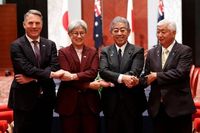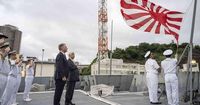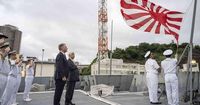In a move that signals a profound shift in Asia-Pacific security dynamics, Australia and Japan have taken decisive steps to strengthen their military and economic partnership, responding to mounting regional tensions and the evolving role of the United States as a security guarantor. The deepening alliance was underscored this week by a series of high-profile meetings and a landmark warship deal that is set to reshape defense cooperation between the two nations.
On September 5, 2025, Australian Defense Minister Richard Marles visited the Japanese Maritime Self-Defense Force’s naval base in Yokosuka, where he toured the JS Mikuma—a Mogami-class frigate built by Mitsubishi Heavy Industries. This vessel is the very model that Australia has chosen to replace its aging ANZAC-class warships, as reported by the Associated Press and Reuters. The visit, hosted by Japanese Defense Minister Gen Nakatani, marked more than just a ceremonial inspection; it was a clear demonstration of growing trust and mutual reliance between Canberra and Tokyo.
Australia’s decision, made just a month prior, to purchase 11 Mogami-class frigates from Japan is historic. Not only does it represent the largest defense export deal for Japan since it lifted its ban on military exports in 2014—worth a staggering A$10 billion (US$6.5 billion)—but it also allows Japan to share cutting-edge weapons systems and sensitive defense secrets with a foreign partner for the first time. According to Reuters, this deal is a major boost for Japan’s still-maturing defense industry, which suffered a setback in 2016 after losing Australia’s submarine contract to France.
Minister Marles did not mince words about the significance of the agreement, stating, “The selection of the Mogami-class frigates as the general-purpose frigate for the Royal Australian Navy is genuinely a milestone moment in the bilateral relationship between Australia and Japan.” His Japanese counterpart, Gen Nakatani, echoed the sentiment, highlighting that the frigate deal would “strengthen supply chain cooperation between the two countries and contribute to the peace and stability of the Indo-Pacific region.”
The symbolism of the JS Mikuma visit was amplified by a larger diplomatic gathering in Tokyo. There, Marles and Australian Foreign Minister Penny Wong joined their Japanese counterparts, Defense Minister Nakatani and Foreign Minister Takeshi Iwaya, for their first “two-plus-two” meeting since September 2024. The timing was notable: just days after China showcased a new array of advanced weaponry in a high-profile military parade, a move that has only heightened anxieties among its regional neighbors.
The tone of the Tokyo talks was one of urgency and unity. “We have agreed to elevate the special strategic partnership between our two countries, looking forward to next year as the 50th anniversary of the Basic Treaty on Friendship and Cooperation,” Marles told reporters, as cited by The Japan Times. The ministers pledged to expand joint military exercises, deepen cooperation on energy and critical minerals, and strengthen coordination in the evacuation of their nationals from overseas emergencies. Such moves, they agreed, are necessary responses to what they described as an “increasingly severe” security environment in the Indo-Pacific region.
Japan and Australia’s alignment is not occurring in a vacuum. Both are close allies of the United States, and both have felt the pressure as Washington calls on its partners to shoulder more of the regional security burden. The two countries are also key members of the Quad, a security grouping that includes the US and India, and have maintained a reciprocal access agreement since 2023 allowing their forces to operate on each other’s territory. According to Reuters, this agreement has laid the groundwork for more integrated military operations and rapid crisis response.
Foreign Minister Iwaya was explicit about the evolving nature of the alliance. “We agreed to further strengthen our collective deterrence capabilities and to activate discussions on potential contingencies that could affect the security of both countries and the region,” he said, according to Reuters. This statement was widely interpreted as a nod to the growing assertiveness of China, whose activities in the South and East China Seas have unsettled neighbors and prompted calls for a more robust regional security architecture.
Beyond the military sphere, economic cooperation is also set to deepen. Australia, traditionally a major supplier of liquefied natural gas to Japan, is looking to expand the relationship into the realm of critical minerals—resources essential for advanced manufacturing, clean energy, and, notably, defense technologies. “We want the next stage of this to be economic security in the area of critical minerals. And we see that as of great importance,” said Foreign Minister Wong during the Tokyo meetings.
For Japan, the frigate deal is a watershed moment. After years of incremental reforms, the country is accelerating its military buildup and expanding defense ties beyond its only treaty ally, the United States. The government has teamed up with Mitsubishi and other manufacturers to promote the frigate project, with officials pledging continued support as they aim to finalize the contract early next year. As The Associated Press reported, Japan now considers Australia to be a semi-ally—a significant shift in its traditionally cautious defense posture.
There are also practical implications for both nations’ defense industries. The shipbuilding deal will bring new investment into Australia, as Japanese firms set up local operations to build most of the vessels. This not only strengthens the industrial base but also fosters technology transfer and workforce development, creating a more resilient and self-sufficient defense ecosystem.
While the rapid warming of Australia-Japan ties is driven in part by shared concerns over China, both governments have been careful to frame their cooperation as defensive and stabilizing. They reiterated the importance of working with the United States and other like-minded partners to ensure peace and stability in the region. Still, the message from Tokyo and Canberra is clear: the security environment is changing, and so too must the alliances that underpin it.
As the Indo-Pacific faces an uncertain future, the strengthened partnership between Japan and Australia stands as a testament to the power of shared interests and mutual trust. With the 50th anniversary of their Basic Treaty on Friendship and Cooperation approaching in 2026, both countries are looking to the future—not just to mark a milestone, but to build a new foundation for regional security.


